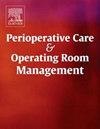Effect of preoperative patient anxiety on post-spinal shivering during non-elective caesarean delivery – A prospective observational study
IF 1
Q2 Nursing
Perioperative Care and Operating Room Management
Pub Date : 2025-08-06
DOI:10.1016/j.pcorm.2025.100538
引用次数: 0
Abstract
Background and aim
Shivering is common in patients undergoing caesarean delivery (CD) under spinal anaesthesia, and can have negative perioperative consequences. Preoperative anxiety has been implicated as a potential non-thermogenic risk factor for post-spinal shivering, although data from obstetric patients is only emerging. This study was conducted to ascertain the relationship between preoperative anxiety and post-spinal shivering in obstetric patients.
Methods
Patients ≥18 years and undergoing non-elective CD (Royal College of Obstetricians and Gynaecologists Categories 2, 3) under spinal anaesthesia were enrolled in this prospective observational study in a university teaching hospital. Preoperative anxiety was assessed using the visual analogue scale (VAS), correlated with the occurrence of post-spinal shivering and analysed using univariate and multivariate logistic regression models.
Results
Of the 150 patients enrolled, 55 (37 %) experienced post-spinal shivering. The relative risk (95 % CI) of post-spinal shivering in patients with high VAS preoperative anxiety was 2.3 (1.4 - 4.0); p = 0.001. VAS anxiety (aOR 1.55; 95 % CI:1.25–1.92; p = 0.001) and history of previous neuraxial anaesthesia for CD (aOR 0.23; 95 % CI: 0.07–0.69; p = 0.009) were independent predictors of shivering after spinal anaesthesia.
Conclusion
High preoperative anxiety is an independent risk factor for post-spinal shivering during non-elective CD. A previous history of neuraxial anaesthesia for prior CD is protective for post-spinal shivering in these patients. Specific perioperative interventions to mitigate patients’ preoperative anxiety might reduce the incidence of post-spinal shivering in these patients, potentially improving perceived quality of care being provided.
术前患者焦虑对非择期剖宫产脊柱后寒战的影响——一项前瞻性观察研究
背景和目的寒战在脊髓麻醉下剖腹产(CD)患者中很常见,并可能产生不良的围手术期后果。术前焦虑被认为是脊髓后寒战的潜在非热源性危险因素,尽管来自产科患者的数据刚刚出现。本研究旨在确定产科患者术前焦虑与脊柱后寒战之间的关系。方法在一所大学教学医院进行前瞻性观察研究,患者年龄≥18岁,在脊髓麻醉下接受非选择性CD (Royal College of Obstetricians and gynaologists Categories 2,3)。术前焦虑使用视觉模拟量表(VAS)进行评估,与脊柱后寒战的发生相关,并使用单因素和多因素logistic回归模型进行分析。结果在150例入组患者中,55例(37%)出现脊髓后寒战。VAS术前焦虑高的患者发生脊髓后寒战的相对危险度(95% CI)为2.3 (1.4 ~ 4.0);P = 0.001。VAS焦虑(aOR 1.55;95% ci: 1.25-1.92;p = 0.001)和既往CD的神经轴麻醉史(aOR 0.23;95% ci: 0.07-0.69;P = 0.009)是脊髓麻醉后寒战的独立预测因子。结论术前高度焦虑是非选择性CD患者脊柱后寒战的独立危险因素。既往CD患者的轴向麻醉史对脊柱后寒战具有保护作用。特定围手术期干预减轻患者术前焦虑可能会减少这些患者脊柱后寒战的发生率,潜在地提高所提供护理的感知质量。
本文章由计算机程序翻译,如有差异,请以英文原文为准。
求助全文
约1分钟内获得全文
求助全文
来源期刊

Perioperative Care and Operating Room Management
Nursing-Medical and Surgical Nursing
CiteScore
1.30
自引率
0.00%
发文量
52
审稿时长
56 days
期刊介绍:
The objective of this new online journal is to serve as a multidisciplinary, peer-reviewed source of information related to the administrative, economic, operational, safety, and quality aspects of the ambulatory and in-patient operating room and interventional procedural processes. The journal will provide high-quality information and research findings on operational and system-based approaches to ensure safe, coordinated, and high-value periprocedural care. With the current focus on value in health care it is essential that there is a venue for researchers to publish articles on quality improvement process initiatives, process flow modeling, information management, efficient design, cost improvement, use of novel technologies, and management.
 求助内容:
求助内容: 应助结果提醒方式:
应助结果提醒方式:


